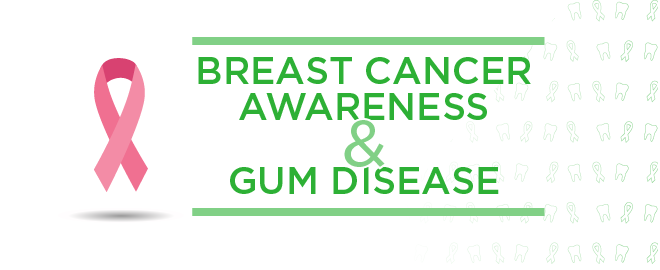Exploring the connection between breast cancer and gum disease
Posted on November 2, 2023 in Healthy You

Your oral health isn’t just limited to your mouth — it can affect your overall health, too.
You may have heard about the links between poor oral health and conditions like diabetes and heart disease, but you may not know that gum disease is also linked to an increased risk of breast cancer.
A closer look at the connection
A number of studies have suggested women with gum disease can be at higher risk of developing breast cancer. Researchers aren’t exactly sure what’s causing the connection. One possibility is that gum disease bacteria can leave the mouth and travel elsewhere in the body through the bloodstream and contribute to other chronic diseases, such as breast cancer. Another idea is that the inflammation caused by gum disease can affect a disease in a different part of the body.1
One study found that overall, the risk of breast cancer was 14% higher in women who had gum disease compared to women with no gum disease. So, if the average breast cancer risk is about 12%, a woman with gum disease had about a 13.5% risk. And women who have a history of smoking had an even higher risk of developing breast cancer.1
More evidence is needed to understand the true connection between gum disease and breast cancer, and it’s not clear whether having good oral health actually lowers your risk of developing breast cancer.
How to limit chemotherapy oral health side effects
Chemotherapy is a common treatment for breast cancer. Chemotherapy has several side effects, including some that affect your teeth and mouth. Common oral health side effects of chemotherapy include:
- Inflammation in the mouth and gums
- Dry mouth
- Increased risk of mouth infection
- Mouth sores
These side effects can affect your quality of life and harm the health of your mouth. Seeing your dentist before starting chemotherapy is a good way to learn more about the potential side effects and how to minimize their impact on your daily life.
How to prevent gum disease
Gum disease has stages ranging from mild (known as gingivitis) to severe (known as periodontitis). Mild gum disease may have no or very minimal symptoms, but your dentist will be able to identify it at a preventive dental exam and give you at-home strategies for reducing your risk of the disease worsening. Good at-home dental hygiene, including twice daily brushing and daily flossing, will help keep gum disease at bay.
Telltale signs of gum disease include red, swollen and bleeding gums. If you notice changes in your gums, call your dentist. It’s much easier to treat gum disease at its early stages than when it’s developed into severe disease.
Scheduling twice yearly dental visits is an important way to understand your risk for gum disease and take steps to address any existing gum disease. Need to find a new dentist? Our Find a Provider tool easily connects you to in-network dentists near you.
REFERENCE
Breastcancer.org